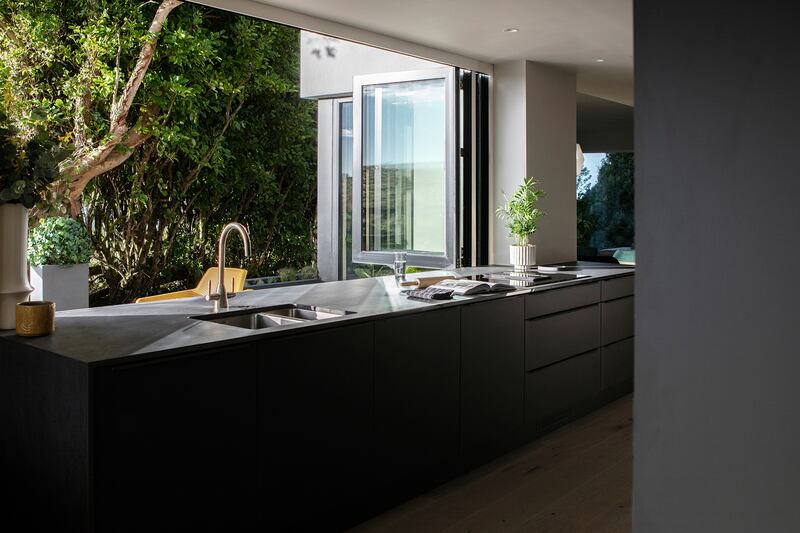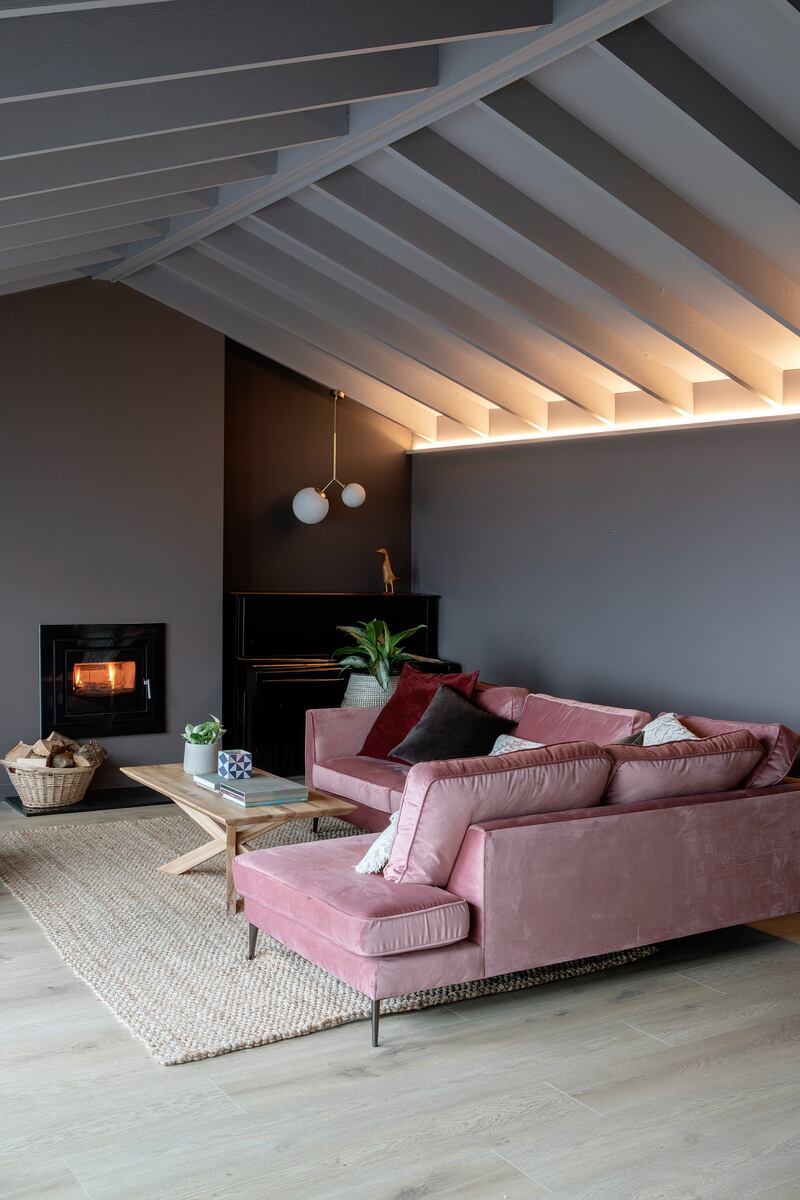1. Get the light right
First of all, it is vital to get to know the orientation of your potential home. Find out which part of the property faces south because that’s where light comes from. This is relatively easy to do using the compass feature on a smartphone and especially helpful during the darker months. It might be raining which will darken the property or if you’re attending an evening viewing it might be getting dark and difficult to get a sense of the available natural light.
Look at where the room layout as it is currently and consider moving the kitchen/living/dining spaces, to the south-facing part of your house. It might mean knocking a few walls and opening up the space and maybe putting in a set of glass double doors in the centre. It is about borrowing light from wherever it comes in. Sometimes a glass screen can be a really good idea, when you don’t want to open up the entire house.
Play with the light and shadow. You can get creative using fabrics and curtains and even slatted timber screens to create what’s known as shadowplay, the movement of light and shade across the space, at different times of the day.
‘A gas emergency would quickly turn into an electricity emergency. It is low-risk, but high-consequence’
How LEO Digital for Business is helping to boost small business competitiveness
‘I have to believe that this situation is not forever’: stress mounts in homeless parents and children living in claustrophobic one-room accommodation
Unlocking the potential of your small business

2. My view on views
In every big house I see or incredible homes from the around the world, the view is what makes it really great. But every house has something outside worth looking at, so if you can open any walls to a garden, it is worth doing. That might mean sacrificing a few storage cabinets, but if you can connect a room to outside, especially a space where you sit and relax, you can double its perceived size.
Even a little courtyard can be great. Seeing plants move in the wind and the colour of the leaves change seasonally is all really good for us. Nature’s patterns and shapes can form relaxing backdrops to a room. It can be down to just creating a window box if you live in an apartment. Window seats are also a thing worth exploring, even in small houses, because it’s somewhere to sit, curl up in and have a nice view. If you can create the right kind of enclosure in that window, it can almost feel like another room without any extra money.
In one house I worked on, the owners didn’t have enough space to install a kitchen island, so I put the kitchen counters right up to the edge of the window and dropped the windowsill right down that height and then put a bifold window in. During the summer you could pull back the entire window and your kitchen space felt like it was outside. For people who are outside, they could sit up at your kitchen ‘island’ but they’re outside.

3. Functionality and storage
This is where people most often go wrong. We live in a visual age where many follow interior decoration accounts on Instagram and other platforms. Home hunters can get caught up trying to achieve a look rather than addressing what the needs of their property. Start by documenting everything you feel you need in a written brief. For example, if you go surfing every weekend, a little space with a drain to dry your wetsuits and storage space for the boards should be on it. Or, if you love to paint and create art or a have hobby how can you accommodate that within the four walls? Is there a space that can do double duty, as a hobby room cum home office or guest bedroom, for example?
People often tell me they really need tonnes of storage, but often this is because they have 20 years of clothes and they have never thrown anything out. Start by decluttering wardrobes and drawers and send garments you no longer love to charity shops.
On recent projects custom-built storage costs an average of €2,500 per square metre to install so consider where you need it. Flexible spaces present much more value to live in. An office space could become a playroom at night. Lots of office set-ups these days just require a laptop, so a quiet corner in a sun-filled living room that could be folded closed at night when you sign off for the day could work well.
I love an open plan space, but we all need somewhere to do the Zoom calls, or to just retreat to watch Netflix, so it’s good to have some kind of separate room. It doesn’t have to be big - it can be a box bedroom with a TV in it and room for two armchairs that then doubles up as your office during the day.
Kitchen islands are very popular these days but make sure you have space for one. If you don’t have at least 140 centimetres, between it and your kitchen counter, you won’t have enough space to walk around. That said, there are options such as islands on wheels that can be stored away during the day when not in use.
4. Tricks with space
Pick a material or colour palette for use throughout the whole house. One timber, such as fashionable pale oak and use with one neutral colour that will work everywhere. I’m not saying to only have one colour but put together a paint sample board and don’t change it. It means you can better connect to the spaces and leave doors open and it will all please the eye more.
I am a fan of a monochrome kitchen. It can help everything feel a bit less fussy. If you look at really, really, high-end kitchens they are generally quite monochrome so don’t be afraid of doing everything in the one colour.
If your home is open plan, you might think of giving the storage units a uniform look throughout the house and continue the look of the kitchen cupboards on into the living area. This uniformity will make the space feel bigger.
When painting walls don’t always follow the fashion to put colour up to the ceiling, because sometimes when you’re sitting down it can make it feel like the ceiling is coming down towards you. By leaving a space, between the picture rail in a period house and the ceiling, it makes the room feel much bigger than it actually is. In a broken-plan room if you are putting a wall between two spaces, consider not bringing the divide right to the ceiling and it will make the ceiling appear higher.

5. Lighting up time
Beware of downlighters. My pet hate is seeing whole ceilings full of them because they don’t throw off a very flattering light. They are grand for task lighting in a kitchen over a countertop but living rooms should have softer lighting options such as indirect lighting bouncing off the ceiling. Pendants can give the illusion of creating a space, like in a theatre and LED lighting recessed into walls or behind roof timbers can work really well. If you’re getting your house rewired it is easy for them to wire it and have six or seven cables lead back down to the switches, but it can be really expensive to do that type of work retrospectively.
Hiring a lighting designer or somebody to help you with that might cost you the same as a coffee table, but it might just be the best money you ever spend as the end result could put more of a smile on your face than any table ever will.

6. Intentionality
Lastly, try and make everything look like you meant it – like the end result was intentional. The more you try to preserve and match up any straight lines and angles in your space the more cohesive the look will be. So, for example, if you are putting tiles up beside a window, always try and have them match to the height of that window. If it looks like you meant it, it will look a hundred times better.
If you’re in the market for a new home then join us at The Bank of Ireland/Irish Times mortgage event, in association with the bank’s director of home buying, Alan Hartley, architect Dermot Bannon and Joanne Geary, MD of property portal MyHome.ie, which is being held at The Irish Times, Liffey House, 24 – 28 Tara Street, D02 CX89, on Thursday evening, January 26th 2023. This event is free to attend but requires advance registration as numbers are limited.
Doors: 6:30pm
Event starts: 7pm
The new series of Room to Improve, sponsored by Bank of Ireland, can be seen on RTE One on Sunday nights at 9.30pm














